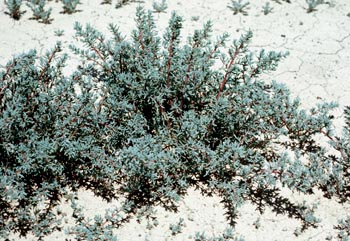Halogeton

Common Name(s):
Halogeton
Saltlover
Scientific Name:
Halogeton glomeratus (Bieb.) C.A. Mey.
Scientific Name Synonyms:
None known
Symbol:
HAGL
Description:
Life Span: Summer annual
Origin: Introduced
Season: Warm
Growth Characteristics: A small forb, growing 3 to 12 inches in height. Stems red when young, turning yellow to white with maturity. Stems are branched from base, spreading first, and then growing vertical. Flowers July to September, and reproduces from seeds.
Flowers/Inflorescence: Small and inconspicuous, in leaf axils. Can be unisexual or complete.
Fruits/Seeds: Reproduces from two types of seed: A black seed, with yellowish or reddish fan-like wings and similar to a snail coil, and a brown wingless seed. The black seed germinates quickly, and the brown seed has delayed germination. Seeds are often very numerous, forming a mass from the ground to the tip of the leaves. Brown seeds can remain viable in the soil for 10 years or more.
Leaves: Alternate, simple, fleshy and tubular. Leaves bluish-green. Has a small hair at the end of the leaves. Leaves resemble a small sausage with a sharp point.
Ecological Adaptions:
Halogeton has become common in dry deserts, barren areas, overgrazed prairies, roadsides, and other disturbed areas where native vegetation has been removed. Dense stands are found on burned-over areas, overgrazed ranges, dry lakebeds, roadsides, and abandoned dry farms.
Soils: Especially abundant in alkaline or saline soils.
Associated Species: Sagebrush, rabbitbrush, cheatgrass, shadscale, greasewood.
Uses and Management:
Halogeton was introduced into North America as late as 1930 and has rapidly spread, becoming a serious weed on rangeland. It cannot compete with desirable forage. Forage value is poor to fair for both cattle and sheep. It provides useable forage only when mixed in small quantities with other forage plants. It is poisonous, and sheep are the most susceptible. It contains toxic amounts of sodium, potassium, and calcium oxalates. Signs of poisoning include: depression, weakness, reluctance to move, drooling, coma, and death. The first signs of poisoning occur 2 to 6 hours after an animal ingests a fatal amount, and death occurs in 9 to 11 hours.
Halogeton cannot compete with healthy range plants. Therefore, control involves keeping a healthy cover of desirable forage plants.

